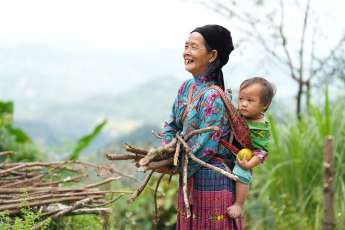
Lolo Chai, a legendary village on the Dong Van plateau
- on Jan 4, 2020 By: Ngoc Nguyen
From the top of Rong Mountain where the Lung Cu flag is raised, Lolo Chai is revealed as a picturesque painting in which man and nature peacefully complement each other. "Chai" means "village" in the local language, Lolo Chai, the most remote village in the Dong Van district, is a passage not to be missed when you arrive on the Dong Van karst plateau.

Staying near a large natural lake which they consider the eye of the protective dragon, the Lolo will tell you the legend of their land. According to which, the place witnessed events linked to national salvation in the presence of the heroes Ly Thuong Kiet of the 12th century and King Quang Trung of the 18th century.
Populated mainly by the Lolo, the hamlet has 105 families including 10 from the Hmong. The Lolo is also one of the most modest among 54 ethnic groups living in Vietnamese territory for their minimal population. After the long journey through the winding loops, Lolo Chai takes you to a small part of the world to discover the authentic life of the inventors of unusual earth homes.
Traditional Lolo house

It is made up of three plain openings, one on the right is the parents' area, on the left is for the children and the rest in the middle serves as a living room. We see in the central hall the sacred place of the house, the ancestral altar which is also occupied for special occasions, marriage and funerals in particular. There is also a mezzanine which is a place for storing food, corn, cassava, potatoes, etc. It can be fitted out to possibly accommodate guests.
A "trinh tuong" house is built mainly of clay and earth, the walls are between 50 and 60 cm thick. It is also called "all season house" for the natural air conditioning it creates despite the outside temperatures. The village has around thirty preserved ancestral houses which allow you to discover an original piece of architecture as well as an astonishing sense of adaptation of the mountain dwellers in Ha Giang.
The most beautiful mountain costume in the North

Dress wise, if the Lolo man is simple enough with pants and a long shirt, the woman is like a living bouquet of flowers. Known as one of the most beautiful and original Vietnamese outfits, the traditional clothing of Lolo women is a real gem.
She dresses like the Kinh for everyday manual work and takes advantage of important parties and occasions to radiate with the particularly shimmering traditional outfit. And it even takes an hour to wear it, according to a granny from Lolo. Very small accessories require time and tremendous thoroughness at each stage. From the embroidered jacket with great refinement to the sophisticated dress combined with the multiple jewels, we see in this superb costume a passion and a tradition out of time. Birds, the sun, plants, rice fields, buckwheat flowers... This dress represents a mirror of the Lolo culture in Ha Giang. The craftswoman must spend two or even three years making such a costume which can cost around fifteen million dong.
Café Cuc Bac

Meaning "Coffee in the Far North", it takes its name from its location at the foot of the Lung Cu flag tower. The peak with the national flag attracts young people who wish to touch the emblematic point of the S-shaped silhouette.
This friendly café has been frequented since 2015 by many hikers in Ha Giang. Maintained by the Diu family, it was created with the support of a Japanese man in love with Vietnam. After the stone fence, we welcome you to enjoy a typical Vietnamese coffee on the terrace of a traditional house. Around a few tablets, you can sip a good coffee and share beautiful moments with the warm Diu family. Lolo life in the karst plateau was based on a culture of rice and one of corn. Living conditions have taken steps forward in recent years with the visit of travellers in search of authentic experiences.
Related articles:
>> The most beautiful setting for the Hmong King in Ha Giang
>> The mountain markets in Ha Giang, colours of the karst mountains
>> Visit Ha Giang during the buckwheat season
Comment
Other Blog
Categories
Latest News
on 31 Dec, 2025
on 31 Dec, 2025
 Español
Español Français
Français




















Morgane Ter Cock
on Dec 18, 2025HerbertPhomaMS
on Oct 19, 2025Lilyan Cuttler
on Oct 15, 2025Avenue17XC
on Sep 14, 2025Avenue18JL
on Jul 21, 2025